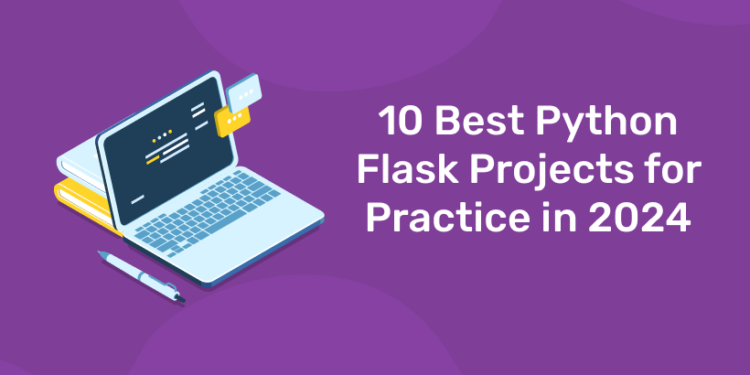Table of Contents
Python Flask serves as an excellent framework for various project practices in 2024. From a simple blog to complex e-commerce platforms, Flask caters to diverse project scopes. Projects like a chat application, issue tracker, or event scheduler refine Flask skills effectively. Implementing stock portfolio trackers or social media dashboards hones real-world application development. Each project provides hands-on experience, enhancing Flask proficiency and versatility in project development. In this article, we will be discussing 10 best python flask projects for Practice in 2024 one by one.
10 Best Python Flask Projects for Practice in 2024
Here’s a list of ten Python Flask project ideas for practice in 2024, varying in complexity.
1. Personal Blog
Create a personal blog platform using Flask. Implement features like user authentication, CRUD operations for blog posts, comments, and a clean, user-friendly UI.
Steps to create the project
Creating a personal blog using Python Flask involves several steps:
Setup and Installation:
- Install Flask using pip install Flask.
- Initialize a Flask application by setting up the directory structure and necessary files.
Project Structure:
- Create directories for templates, static files (CSS, JavaScript), and Python files.
- Structure your project to include separate folders for HTML templates, such as templates/, and static files in static/ for CSS, JavaScript, and images.
Database Setup (Optional):
- Decide whether to use a database to store blog posts, comments, and user data. Popular choices include SQLite, PostgreSQL, or SQLAlchemy for ORM.
- Define database models if using SQLAlchemy to represent blog posts, users, comments, etc.
User Authentication and Authorization:
- Implement user authentication to allow users to sign up, log in, log out, and manage their accounts.
- Set up sessions or tokens to authenticate users and restrict access to certain functionalities (e.g., posting blogs) to authenticated users only.
Grab the opportunity to learn Python with Industry Experts! Get a free Demo Here!
Creating Blog Posts:
- Design a form or interface for users to create new blog posts. Include fields for title, content, categories, tags, etc.
- Store blog posts in the database or as files on the server, and implement functionalities to display, edit, and delete posts.
Displaying Blog Posts:
- Create routes and view functions to render blog posts dynamically on different pages.
- Use templates to structure how blog posts are displayed. Include pagination for multiple posts.
Comments and Interactivity:
- Allow users to comment on blog posts. Implement functionalities to add, display, and manage comments associated with each post.
- Consider adding features like like/dislike buttons, sharing options, or social media integration.
Design and User Interface:
- Develop a clean and user-friendly interface using HTML templates, CSS for styling, and JavaScript for interactivity.
- Focus on responsive design to ensure the blog looks good on various devices.
Testing and Debugging:
- Test the application thoroughly to ensure all functionalities work as expected.
- Handle errors and exceptions gracefully and implement logging for debugging purposes.
Deployment:
- Deploy the Flask application to a web server or hosting service like Heroku, AWS, or DigitalOcean to make the blog accessible online.
Remember to follow Flask’s routing system, use Jinja2 templating for rendering HTML templates, and apply proper security practices, including input validation and protecting against common web vulnerabilities like SQL injection or cross-site scripting (XSS).
2. Task Manager
Develop a task management application allowing users to create, update, delete tasks, set deadlines, and organize tasks by categories or priority levels.
Steps to create the project
Creating a Task Manager application using Python Flask involves several steps:
Setup and Installation:
- Install Flask using pip install Flask.
- Initialize a Flask application by setting up the directory structure and necessary files.
Project Structure:
- Organize your project with directories for templates, static files (CSS, JavaScript), and Python files.
- Structure your project with separate folders for HTML templates (e.g., templates/) and static files in static/ for CSS, JavaScript, and images.
Database Setup (Optional):
- Decide if you’ll use a database to store tasks. Choices include SQLite, PostgreSQL, or SQLAlchemy for ORM.
- Define database models if using SQLAlchemy to represent tasks, task categories, statuses, etc.
Task Management Functionality:
- Create functionalities to manage tasks, including adding, editing, deleting, and marking tasks as complete or incomplete.
- Design a user interface for users to interact with tasks, including forms for task creation and modification.
Task Categories and Sorting:
- Allow users to categorize tasks into different categories (e.g., work, personal, urgent) and implement functionalities to sort tasks based on categories or priority levels.
- Include features to filter and search for tasks by category, status, or due date.
User Authentication and Authorization:
- Implement user authentication to allow users to sign up, log in, log out, and manage their accounts.
- Use sessions or tokens to authenticate users and restrict access to certain functionalities (e.g., managing tasks) to authenticated users only.
Task Display and Interaction:
- Create routes and view functions to display tasks dynamically on different pages.
- Use templates to structure how tasks are displayed. Include pagination for multiple tasks.
User Interface Design:
- Develop a user-friendly interface using HTML templates, CSS for styling, and JavaScript for interactivity.
- Focus on creating a clean and intuitive UI that allows users to manage tasks efficiently.
Testing and Debugging:
- Thoroughly test the application to ensure all functionalities work as expected.
- Handle errors and exceptions gracefully and implement logging for debugging purposes.
Deployment:
- Deploy the Flask application to a web server or hosting services like Heroku, AWS, or DigitalOcean to make the task manager accessible online.
Adopt Flask’s routing system, use Jinja2 templating for rendering HTML templates, and prioritize security practices by validating inputs and protecting against common web vulnerabilities.
3. E-commerce Website
Build an e-commerce site with Flask where users can browse products, add items to a cart, proceed to checkout, and manage their orders.
Steps to create the project
Creating an E-commerce website using Python Flask involves several steps:
Setup and Installation:
- Install Flask using pip install Flask.
- Initialize a Flask application by setting up the directory structure and necessary files.
Project Structure:
- Organize your project with directories for templates, static files (CSS, JavaScript), and Python files.
- Structure your project with separate folders for HTML templates (e.g., templates/) and static files in static/ for CSS, JavaScript, images, etc.
Database Setup:
- Choose a database system (e.g., SQLite, PostgreSQL) to store product details, user information, orders, etc.
- Define database models using SQLAlchemy if using, to represent products, users, orders, etc.
User Authentication and Authorization:
- Implement user authentication allowing users to sign up, log in, log out, and manage their accounts.
- Use sessions or tokens to authenticate users and restrict access to certain functionalities (e.g., making purchases) to authenticated users only.
Product Catalog and Management:
- Develop functionalities to display products with details such as name, description, price, images, etc.
- Implement features to manage products, including adding new products, updating existing ones, and deleting if necessary.
Shopping Cart and Checkout Process:
- Create a shopping cart system allowing users to add products, manage quantities, and proceed to checkout.
- Implement a checkout process including order summary, shipping details, payment integration (if applicable), and order placement.
Order Management and Tracking:
- Design functionalities for users to view their order history, track order status, and manage orders (e.g., cancel or return orders).
Search and Filtering:
- Include search functionality allowing users to search for products by name, category, or keywords.
- Implement filters for users to refine their product searches based on price, brand, ratings, etc.
User Interface Design:
- Develop a user-friendly interface using HTML templates, CSS for styling, and JavaScript for interactivity.
- Focus on creating a visually appealing and intuitive UI that enhances the shopping experience.
Testing and Deployment:
- Thoroughly test the application to ensure all functionalities work as expected, handle errors, and implement logging for debugging purposes.
- Deploy the Flask application to a web server or hosting service to make the e-commerce website accessible online.
4. Social Media Dashboard
Construct a social media dashboard integrating APIs (e.g., Twitter, Instagram) to fetch and display user feeds, posts, and engagement metrics.
Steps to create the project
Creating a Social Media Dashboard using Python Flask involves several steps:
Setup and Installation:
- Install Flask using pip install Flask.
- Initialize a Flask application by setting up the directory structure and necessary files.
Project Structure:
- Organize your project with directories for templates, static files (CSS, JavaScript), and Python files.
- Structure your project with separate folders for HTML templates (e.g., templates/) and static files in static/ for CSS, JavaScript, images, etc.
Integration with Social Media APIs:
- Choose the social media platforms (e.g., Twitter, Instagram, Facebook) you want to integrate.
- Obtain API access and keys from respective platforms to fetch user feeds, posts, and engagement metrics.
User Authentication and Authorization:
- Implement user authentication allowing users to sign up, log in, log out, and manage their accounts.
- Use sessions or tokens to authenticate users and restrict access to the dashboard functionalities to authenticated users only.
Fetching and Displaying Social Media Feeds:
- Create functionalities to fetch user feeds, posts, and engagement metrics using the social media APIs.
- Display fetched data on the dashboard using templates, and organize it in a user-friendly manner.
Engagement Metrics and Analytics:
- Retrieve engagement metrics like likes, shares, comments, etc., for posts and display them in charts or graphs.
- Implement analytics to show user engagement trends, popular posts, or user activity insights.
User Interaction and Actions:
- Allow users to perform actions on social media platforms through the dashboard (e.g., post updates, reply to comments, share content).
- Design interfaces for users to interact with the fetched data, like and comment on posts, or follow/unfollow users.
Search and Filtering:
- Implement functionalities for users to search for specific posts, users, or content based on keywords, hashtags, or user handles.
- Include filters to refine searches by date, type of content, or engagement metrics.
User Interface Design:
- Develop a user-friendly interface using HTML templates, CSS for styling, and JavaScript for interactivity.
- Focus on creating a visually appealing dashboard that provides an organized view of social media data.
Testing and Deployment:
- Thoroughly test the application to ensure all functionalities work as expected, handle errors, and implement logging for debugging purposes.
- Deploy the Flask application to a web server or hosting service to make the social media dashboard accessible online.
5. Recipe Sharing App
Develop a recipe sharing platform where users can create, share, and explore recipes. Include features like search, rating, and categorization.
Steps to create the project
Creating a Recipe Sharing App using Python Flask involves several steps:
Setup and Installation:
- Install Flask using pip install Flask.
- Initialize a Flask application by setting up the directory structure and necessary files.
Project Structure:
- Organize your project with directories for templates, static files (CSS, JavaScript), and Python files.
- Structure your project with separate folders for HTML templates (e.g., templates/) and static files in static/ for CSS, JavaScript, images, etc.
Database Setup:
- Choose a database system (e.g., SQLite, PostgreSQL) to store recipes, user information, comments, etc.
- Define database models using SQLAlchemy if using, to represent recipes, users, comments, etc.
User Authentication and Authorization:
- Implement user authentication allowing users to sign up, log in, log out, and manage their accounts.
- Use sessions or tokens to authenticate users and restrict access to certain functionalities (e.g., creating and editing recipes) to authenticated users only.
Recipe Management Functionality:
- Develop functionalities to manage recipes, including adding new recipes, editing existing ones, and deleting if necessary.
- Create forms or interfaces for users to input recipe details such as name, ingredients, directions, images, categories, etc.
Recipe Display and Interaction:
- Create routes and view functions to display recipes dynamically on different pages.
- Use templates to structure how recipes are displayed, including details, images, ratings, and user comments.
Comments and Ratings:
- Allow users to comment on recipes. Implement functionalities to add, display, and manage comments associated with each recipe.
- Include a rating system for users to rate recipes and display average ratings.
Search and Filtering:
- Implement search functionality allowing users to search for recipes by name, category, ingredients, or keywords.
- Include filters for users to refine their recipe searches based on various criteria like dietary preferences, cuisine, etc.
User Interface Design:
- Develop a user-friendly interface using HTML templates, CSS for styling, and JavaScript for interactivity.
- Focus on creating an intuitive UI that allows users to explore and share recipes easily.
Testing and Deployment:
- Thoroughly test the application to ensure all functionalities work as expected, handle errors, and implement logging for debugging purposes.
- Deploy the Flask application to a web server or hosting service to make the recipe sharing app accessible online.
6. Job Board Application
Build a job board allowing users to post job listings, search for jobs based on filters, and apply to listings. Implement user authentication and job management functionalities.
Steps to create the project
Creating a Job Board Application using Python Flask involves the following steps:
Setup and Installation:
- Install Flask using pip install Flask.
- Initialize a Flask application by setting up the directory structure and necessary files.
Project Structure:
- Organize your project with directories for templates, static files (CSS, JavaScript), and Python files.
- Structure your project with separate folders for HTML templates (e.g., templates/) and static files in static/ for CSS, JavaScript, images, etc.
Database Setup:
- Choose a database system (e.g., SQLite, PostgreSQL) to store job listings, user information, applications, etc.
- Define database models using SQLAlchemy if using, to represent job listings, users, applications, etc.
User Authentication and Authorization:
- Implement user authentication allowing users to sign up, log in, log out, and manage their accounts.
- Use sessions or tokens to authenticate users and restrict access to certain functionalities (e.g., posting jobs, applying to jobs) to authenticated users only.
Job Listings Management Functionality:
- Develop functionalities to manage job listings, including adding new job listings, editing existing ones, and deleting if necessary.
- Create forms or interfaces for employers to input job details such as title, description, requirements, location, salary, etc.
Job Search and Application:
- Create routes and view functions to display job listings dynamically on different pages.
- Implement functionalities for job seekers to search for jobs by criteria like title, location, category, etc.
- Develop a system for job seekers to apply to job listings, including submission forms and managing applications.
User Interface Design:
- Develop a user-friendly interface using HTML templates, CSS for styling, and JavaScript for interactivity.
- Create distinct interfaces for employers to post jobs and manage listings, and for job seekers to search and apply for jobs.
Filters and Sorting:
- Implement filters to refine job searches based on various criteria like job type, salary range, industry, etc.
- Include sorting options to organize job listings by date posted, relevance, or other parameters.
Email Notifications (Optional):
- Consider implementing email notifications for users upon job application submission or when new jobs matching their criteria are posted.
Testing and Deployment:
- Thoroughly test the application to ensure all functionalities work as expected, handle errors, and implement logging for debugging purposes.
- Deploy the Flask application to a web server or hosting service to make the job board accessible online.
7. Stock Portfolio Tracker
Create a stock portfolio management tool where users can track their investments, view stock details, get real-time data using APIs, and analyze portfolio performance.
Steps to create the project
Creating a Stock Portfolio Tracker using Python Flask involves the following steps:
Setup and Installation:
- Install Flask using pip install Flask.
- Initialize a Flask application by setting up the directory structure and necessary files.
Project Structure:
- Organize your project with directories for templates, static files (CSS, JavaScript), and Python files.
- Structure your project with separate folders for HTML templates (e.g., templates/) and static files in static/ for CSS, JavaScript, images, etc.
Database Setup (Optional):
- Decide if you want to use a database to store portfolio data, transactions, user information, etc. Options include SQLite, PostgreSQL, or SQLAlchemy for ORM.
- Define database models if using, to represent portfolio holdings, transactions, user details, etc.
User Authentication and Authorization:
- Implement user authentication allowing users to sign up, log in, log out, and manage their accounts.
- Use sessions or tokens to authenticate users and restrict access to portfolio functionalities to authenticated users only.
Stock Data Integration:
- Integrate with financial APIs (e.g., Alpha Vantage, Yahoo Finance) to fetch real-time or historical stock data, including prices, market trends, company information, etc.
- Implement functionalities to search for and add stocks to the portfolio, retrieve stock data, and update portfolio holdings.
Portfolio Management Functionality:
- Develop functionalities to manage portfolio holdings, including adding new holdings, buying/selling stocks, viewing holdings, and their performance.
- Create forms or interfaces for users to input transactions, such as buy/sell orders, quantities, prices, dates, etc.
Display and Analysis:
- Create routes and view functions to display portfolio holdings dynamically on different pages.
- Use templates to structure how portfolio holdings are displayed, including detailed views, performance charts, graphs, and analysis tools.
User Interface Design:
- Develop a user-friendly interface using HTML templates, CSS for styling, and JavaScript for interactivity.
- Design the interface to provide an intuitive view of portfolio performance, holdings, gains/losses, and trends.
Alerts and Notifications (Optional):
- Implement optional features like price alerts or notifications for specific stock movements, portfolio changes, or financial news.
Testing and Deployment:
- Thoroughly test the application to ensure all functionalities work as expected, handle errors, and implement logging for debugging purposes.
- Deploy the Flask application to a web server or hosting service to make the stock portfolio tracker accessible online.
8. Chat Application
Develop a real-time chat application using Flask-SocketIO for instant messaging, allowing users to create chat rooms, send messages, and view online users.
Steps to create the project
Creating a Chat Application using Python Flask involves the following steps:
Setup and Installation:
- Install Flask using pip install Flask.
- Initialize a Flask application by setting up the directory structure and necessary files.
Project Structure:
- Organize your project with directories for templates, static files (CSS, JavaScript), and Python files.
- Structure your project with separate folders for HTML templates (e.g., templates/) and static files in static/ for CSS, JavaScript, images, etc.
Database Setup (Optional):
- Decide if you want to use a database to store chat messages, user information, etc. Options include SQLite, PostgreSQL, or SQLAlchemy for ORM.
- Define database models if using, to represent users, chat rooms, messages, etc.
User Authentication and Authorization:
- Implement user authentication allowing users to sign up, log in, log out, and manage their accounts.
- Use sessions or tokens to authenticate users and restrict access to chat functionalities to authenticated users only.
Real-Time Communication:
- Implement real-time communication using Flask-SocketIO or similar libraries to enable WebSocket connections for instant messaging.
- Create functionalities to join chat rooms, send and receive messages, and handle real-time updates.
Chat Room Management:
- Develop functionalities to create new chat rooms, join existing rooms, leave rooms, and manage room settings (e.g., privacy, access control).
Message Display and Interaction:
- Create routes and view functions to display chat rooms and messages dynamically on different pages.
- Use templates to structure how messages are displayed, including user avatars, timestamps, and message threading.
User Interface Design:
- Develop a user-friendly interface using HTML templates, CSS for styling, and JavaScript for interactivity.
- Design the chat interface to allow users to interact seamlessly, view conversations, and send messages easily.
Security Considerations:
- Implement security measures to protect against common vulnerabilities, including input validation, sanitization, and preventing script injections.
Testing and Deployment:
- Thoroughly test the application to ensure all functionalities work as expected, handle errors, and implement logging for debugging purposes.
- Deploy the Flask application to a web server or hosting service to make the chat application accessible online.
Ensure the application follows Flask’s routing system, uses Jinja2 templating for rendering HTML templates, and handles WebSocket connections effectively for real-time communication.
9. Issue Tracker
Build a project issue tracker for managing software development issues. Include functionalities for issue creation, assignment, status updates, and comments.
Steps to create the project
Creating an Issue Tracker using Python Flask involves the following steps:
Setup and Installation:
- Install Flask using pip install Flask.
- Initialize a Flask application by setting up the directory structure and necessary files.
Project Structure:
- Organize your project with directories for templates, static files (CSS, JavaScript), and Python files.
- Structure your project with separate folders for HTML templates (e.g., templates/) and static files in static/ for CSS, JavaScript, images, etc.
Database Setup:
- Choose a database system (e.g., SQLite, PostgreSQL) to store issues, user information, comments, etc.
- Define database models using SQLAlchemy if using, to represent issues, users, comments, etc.
User Authentication and Authorization:
- Implement user authentication allowing users to sign up, log in, log out, and manage their accounts.
- Use sessions or tokens to authenticate users and restrict access to issue tracking functionalities to authenticated users only.
Issue Management Functionality:
- Develop functionalities to manage issues, including creating new issues, updating issue status, assigning issues, adding comments, and closing issues.
- Create forms or interfaces for users to input issue details such as title, description, status, priority, labels, etc.
Display and Interaction:
- Create routes and view functions to display issues dynamically on different pages.
- Use templates to structure how issues are displayed, including detailed views, comments, and status updates.
Filtering and Sorting:
- Implement filters to refine issue searches based on various criteria like status, priority, assignee, etc.
- Include sorting options to organize issues by date created, last updated, or other parameters.
User Interface Design:
- Develop a user-friendly interface using HTML templates, CSS for styling, and JavaScript for interactivity.
- Design the interface to provide an intuitive view of issue status, details, comments, and actions for issue management.
Notifications and Alerts (Optional):
- Consider implementing notifications or alerts for users upon issue assignment, status change, new comments, etc.
Testing and Deployment:
- Thoroughly test the application to ensure all functionalities work as expected, handle errors, and implement logging for debugging purposes.
- Deploy the Flask application to a web server or hosting service to make the issue tracker accessible online.
10. Event Scheduler
Create an event scheduling app allowing users to create events, invite attendees, set reminders, and display events in a calendar view.
Steps to create the project
Creating an Event Scheduler using Python Flask involves the following steps:
Setup and Installation:
- Install Flask using pip install Flask.
- Initialize a Flask application by setting up the directory structure and necessary files.
Project Structure:
- Organize your project with directories for templates, static files (CSS, JavaScript), and Python files.
- Structure your project with separate folders for HTML templates (e.g., templates/) and static files in static/ for CSS, JavaScript, images, etc.
Database Setup:
- Choose a database system (e.g., SQLite, PostgreSQL) to store event details, user information, etc.
- Define database models using SQLAlchemy if using, to represent events, users, reminders, etc.
User Authentication and Authorization:
- Implement user authentication allowing users to sign up, log in, log out, and manage their accounts.
- Use sessions or tokens to authenticate users and restrict access to event scheduling functionalities to authenticated users only.
Event Management Functionality:
- Develop functionalities to manage events, including creating new events, updating event details, setting reminders, and deleting events.
- Create forms or interfaces for users to input event details such as title, date, time, location, description, etc.
Display and Interaction:
- Create routes and view functions to display events dynamically on different pages.
- Use templates to structure how events are displayed, including detailed views, reminders, and actions for event management.
Calendar and Scheduling View:
- Implement a calendar view or schedule layout to visualize events based on dates, weeks, or months.
- Allow users to interact with the calendar, view events, and navigate through different dates.
Reminders and Notifications:
- Develop functionality to set reminders for events and implement notifications/alerts to remind users about upcoming events.
User Interface Design:
- Develop a user-friendly interface using HTML templates, CSS for styling, and JavaScript for interactivity.
- Design the interface to provide an intuitive view of scheduled events, reminders, and actions for managing events.
Testing and Deployment:
- Thoroughly test the application to ensure all functionalities work as expected, handle errors, and implement logging for debugging purposes.
- Deploy the Flask application to a web server or hosting service to make the event scheduler accessible online.
Note: Ensure the application follows Flask’s routing system, uses Jinja2 templating for rendering HTML templates, and applies security measures by validating inputs and protecting against common web vulnerabilities.
Grab the opportunity to learn Python with Industry Experts! Get a free Demo Here!
Conclusion:
1: Which of the following data types is immutable in Python?
Flask offers versatile projects – blogs, e-commerce, chats – refining skills at varied levels. Practice on stock trackers, issue managers amplifies real-world app development expertise. Engaging in Flask projects cultivates practical abilities, enriching proficiency and readiness for diverse challenges.
|
Check out These High Demanded Courses |
|
Frequently Asked Questions
What are some beginner-friendly Flask project ideas for practice?
Simple blog, to-do list app, or a basic CRUD (Create, Read, Update, Delete) application.
What are intermediate-level Flask project suggestions for skill improvement?
E-commerce website, social media dashboard, or a stock portfolio tracker.
Are there any advanced Flask project ideas for experienced developers?
Real-time chat application, issue tracker, event scheduler, or job board platform.
How can I choose a Flask project that suits my skill level?
Assess your comfort level with Flask and choose projects aligned with your expertise and learning goals.
Where can I find resources or tutorials to guide me through Flask projects?
Online platforms like Real Python, Flask documentation, and tutorial websites offer comprehensive guidance.
What should I focus on while working on Flask projects for practice?
Emphasize proper project structuring, utilization of Flask’s features, and understanding how different components interact.
Is it essential to complete entire projects, or can I work on specific features for practice?
Both approaches are valuable. Start with smaller features and gradually progress to full projects for a well-rounded understanding.
How can I debug and troubleshoot issues while working on Flask projects?
Use Flask’s debugging tools, error logs, and explore online communities or forums for assistance.
Should I aim for deploying my Flask projects online?
Deploying projects allows you to practice hosting, showcasing, and handling real-time scenarios.
How can Flask projects for practice contribute to my learning and career growth?
Hands-on practice enhances your Flask skills, boosts problem-solving abilities, and strengthens your portfolio for career advancement.












